Epson 3020E, 3020 User Manual
PowerLite® Home Cinema 3020/3020e
Home Theater Projector
User’s Guide
Contents
Introduction |
6 |
Projector Parts |
7 |
Remote Control – PowerLite Home Cinema 3020 |
9 |
Remote Control – PowerLite Home Cinema 3020e |
10 |
WirelessHD Transmitter – PowerLite Home Cinema 3020e |
11 |
Optional Accessories |
12 |
Registration and Warranty |
12 |
Using This Manual |
13 |
Setting Up the Projector |
14 |
Choose a Location |
14 |
Installing the Projector |
17 |
Connecting the Cables |
19 |
Connecting Video and Computer Equipment |
19 |
Making Other Connections |
22 |
Installing Batteries in the Remote Control |
23 |
Charging the 3D Glasses |
23 |
Turning the Projector On and Off |
25 |
Turning On the Projector |
25 |
Turning Off the Projector |
26 |
Selecting the Image Source |
26 |
Positioning the Image |
27 |
Making Basic Adjustments |
29 |
Focusing and Zooming |
29 |
Choosing the Aspect Ratio |
30 |
Viewing 3D images |
31 |
Projecting in Split Screen mode |
33 |
Starting a Slideshow |
35 |
2 Contents
Choosing Slideshow Options |
36 |
Choosing the Color Mode |
37 |
Advanced Color Adjustments |
38 |
Adjusting the Gamma Setting |
39 |
Adjusting RGBCMY |
40 |
Locking the Projector |
40 |
Making Detailed Adjustments |
42 |
Using the Menu System |
42 |
Changing How the Menus Display |
43 |
Adjusting the Picture Quality |
44 |
Input Brightness Settings |
44 |
Sharpness and Picture Quality Settings |
46 |
Color Settings |
47 |
3D Setup |
49 |
Adjustments for Computer Images |
50 |
WirelessHD Settings (PowerLite Home Cinema 3020e only) |
51 |
Split Screen Setup |
52 |
Selecting Memory Settings and Resetting the Projector |
53 |
Creating Memory Settings |
53 |
Selecting Memory Settings |
53 |
Renaming Memory Settings |
54 |
Deleting Saved Memory Settings |
54 |
Resetting the Projector |
55 |
Customizing Projector Features |
56 |
Image Sizing |
56 |
Screen Options |
57 |
Other Setup Options |
57 |
Contents 3
Using WirelessHD |
60 |
Placing the WirelessHD Transmitter |
60 |
Connecting the WirelessHD Transmitter |
61 |
Viewing WirelessHD Content |
62 |
Switching WirelessHD Sources |
62 |
Using Picture-in-Picture |
64 |
Using HDMI Link |
66 |
Setting Up HDMI Link |
66 |
Changing HDMI Link Settings |
67 |
Maintenance |
68 |
Cleaning the Lens |
68 |
Cleaning the 3D Glasses |
69 |
Cleaning the Projector Case |
69 |
Cleaning and Replacing the Air Filter |
70 |
Replacing the Lamp |
72 |
Resetting the Lamp Usage Timer |
75 |
Checking the Projector Status |
75 |
Storing the Projector |
76 |
Transporting the Projector |
76 |
Problem Solving |
77 |
What To Do When the Lights Come On or Flash |
77 |
Solving Picture Problems |
79 |
Solving Remote Control Problems |
83 |
Solving WirelessHD Problems (PowerLite Home Cinema 3020e Only) |
84 |
Where to Get Help |
85 |
4 Contents
Specifications |
86 |
General |
86 |
Lamp |
86 |
Remote Control |
87 |
WirelessHD Transmitter (Home Cinema 3020e only) |
87 |
Dimensions |
87 |
Electrical |
88 |
Environmental |
88 |
Safety |
88 |
Compatible Video Formats |
89 |
ESC/VP21 Command Codes |
91 |
Notices |
92 |
Important Safety Information |
92 |
FCC Compliance Statement |
94 |
Copyright Notice |
95 |
A Note Concerning Responsible Use of Copyrighted Materials |
95 |
Trademarks |
96 |
Contents 5
Introduction
The PowerLite® Home Cinema 3020/3020e projector lets you enjoy theater-quality 2D and 3D images in the relaxing environment of your own home. Designed especially for home cinema use, it offers these outstanding features:
■Native 1080p (1920 × 1080) resolution, dynamic contrast ratio up to 40,000:1 and up to 2200 lumens of brightness (white light output) for incredibly rich, sharp images in any room lighting
■Auto Iris system that constantly controls the light output based on the gamma and black/white levels of your projected content, for perfectly adjusted images and deepest blacks
■Epson® C2FineTM 3LCD technology for reliable picture quality, increased contrast ratio and uniform colors
■10-bit color quality for unmatched color accuracy, with over a billion colors available
■HDMI® (High-Definition Multimedia Interface®) ports for superior, uncompressed digital video
■True 16:9 wide-format projection
■Powerful 10 W per channel stereo system with two speakers
■Flexible setup configurations, including front projection and ceiling mounted, with horizontal keystone slider for offset placement
6 Introduction
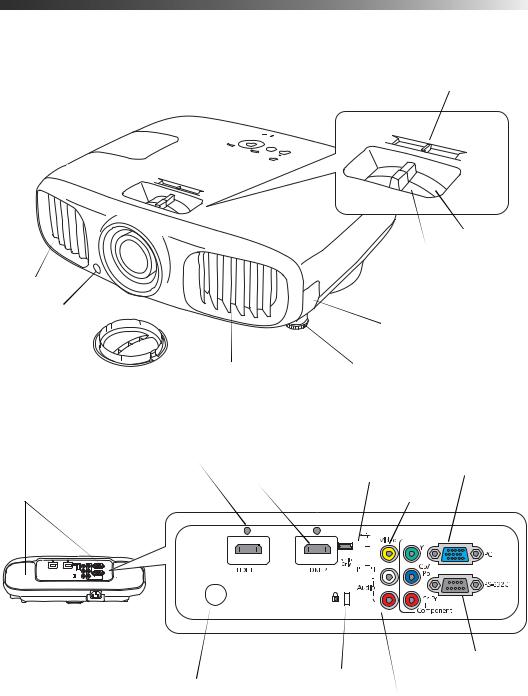
Projector Parts
Front
Control panel |
Horizontal keystone slider |
|
Lamp cover 
Zoom ring
|
|
Focus ring |
Air exhaust |
|
|
Remote receiver |
|
|
|
|
Air filter cover |
Lens cover |
Air intake |
Adjustable foot |
Back
Cable clip hole |
Cable clip hole |
|
|
|
|
HDMI ports |
|
USB port |
PC port |
|
|
|
||
Speakers |
|
|
Video port |
|
|
|
|
|
|
|
|
|
|
|
|
|
|
|
|
|
|
|
|
|
|
|
|
|
|
|
|
|
|
|
|
|
|
|
|
|
|
|
|
|
|
|
|
|
|
|
|
|
|
|
|
|
|
|
|
|
|
|
|
|
|
|
|
|
|
|
|
|
|
|
|
|
|
|
|
|
|
|
|
|
|
|
|
|
|
|
|
|
|
|
|
|
|
|
|
|
|
|
|
|
|
|
|
|
|
|
|
|
|
|
|
|
|
|
|
|
|
|
|
|
|
|
|
|
|
|
|
|
|
|
|
|
|
|
|
|
|
|
|
|
|
|
|
|
|
|
|
|
|
Power inlet |
|
|
|
|
|
|
|
|
|
|
|
|
|
RS-232C port |
|
|
Remote receiver |
|
|
Kensington® lock port |
Component port |
||||||||||
|
|
|
|
|
|
|
|
|
|
|
|
|
|||
Audio (L-R) port
Introduction 7

Bottom
Mounting bracket attachment points
Front adjustable feet
Projector Control Panel
Volume/horizontal keystone buttons
Brightness sensor
Escape button
Power light
|
Vertical |
|
keystone |
Power button |
buttons |
Source button
Lamp |
|
|
|
|
|
Temperature |
light |
|
|
|
|
light |
|
8 Introduction
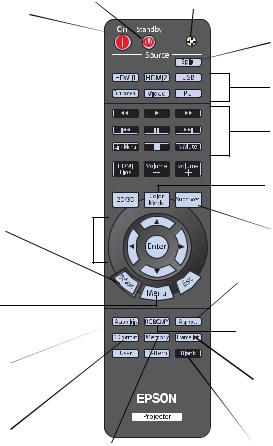
Remote Control – PowerLite Home Cinema 3020
|
Standby button |
Illumination button |
|
On button |
Lights the remote control |
||
Turns projector off |
|||
buttons for easy viewing |
|||
Turns projector on |
|
||
|
Split button |
||
|
|
||
|
|
Toggles the Split |
|
HDMI Link button |
|
Screen function on or |
|
|
off |
||
Enables and disables the |
|||
Source buttons |
|||
HDMI link function |
|
||
|
|
Switch between equipment |
|
2D/3D button |
|
connected to the projector |
|
|
|
||
Toggles |
|
HDMI Link control buttons |
|
between 2D and |
|
Control playback of a linked |
|
3D projection |
|
video device |
|
|
|
||
Menu |
|
Color Mode button |
|
navigation |
|
Quickly change color settings |
|
buttons |
|
to match room lighting |
|
Default button |
|
Super-res button |
|
Resets menu |
|
Adjusts the Super-res setting |
|
selection to default |
|
on or off |
|
values |
|
Aspect button |
|
|
|
||
Menu button |
|
Changes the picture’s aspect ratio |
|
|
|
||
Displays the projector’s |
|
|
|
menus |
|
RGBCMY button |
|
|
|
||
|
|
Displays the color adjustment menu |
|
Auto Iris button |
|
|
|
Toggles the Auto Iris |
|
Frame int setting |
|
function on or off |
|
||
|
Adjusts the Frame Interpolation |
||
|
|
||
|
|
setting |
|
3D Format button |
Memory button |
Blank button |
|
Adjusts the 3D |
|||
Temporarily stops projection or |
|||
Format setting |
Accesses the memory menu |
||
|
|||
hides the menu screen
Introduction 9
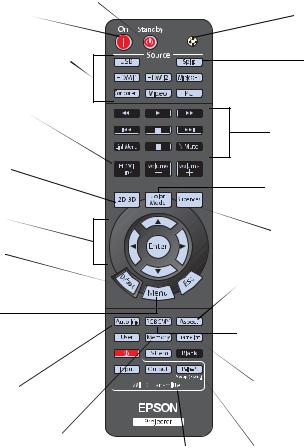
Remote Control – PowerLite Home Cinema 3020e
|
Standby button |
On button |
Turns projector off |
Turns projector on |
|
Source buttons |
|
Switch between equipment |
|
connected to the projector |
|
HDMI Link button |
|
Enables and disables the |
|
HDMI link function |
|
2D/3D button |
|
Toggles |
|
between 2D and |
|
3D projection |
|
Menu |
|
navigation |
|
buttons |
|
Default button |
|
Resets menu |
|
selection to default |
|
values |
|
Menu button |
|
Displays the projector’s |
|
menus |
|
Auto Iris button |
|
Toggles the Auto Iris |
|
function on or off |
|
Illumination button
Lights the remote control buttons for easy viewing
Split button
Toggles the Split Screen function on or off
HDMI Link control buttons
Control playback of a linked video device
Color Mode button
Quickly change color settings to match room lighting
Super-res button
Adjusts the Super-res setting on or off
Aspect button
Changes the picture’s aspect ratio
RGBCMY button
Displays the color adjustment menu
Frame Int button
Adjusts the Frame Interpolation setting
Memory button |
WirelessHD |
Blank button |
|
Accesses the |
|||
Temporarily stops projection or |
|||
memory menu |
Transmitter |
||
hides the menu screen |
|||
|
controls |
||
|
|
10 Introduction
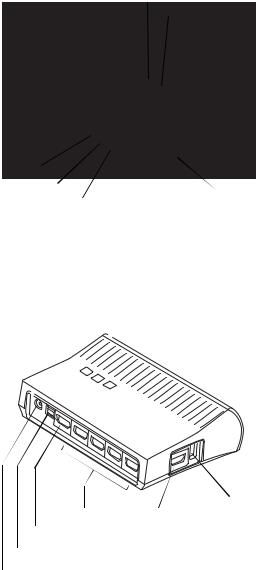
WirelessHD Transmitter – PowerLite Home Cinema 3020e
Front
Power button
Input button
Output button
 Power switch
Power switch
Power light
WiHD light
Link light
Setup/Reset button (bottom of transmitter)
Back
3D glasses charging port
HDMI input ports HDMI output port
Optical Audio Out port
AC adapter port
Introduction 11

Optional Accessories
Epson provides the following optional accessories for the projector:
Product |
Part number |
|
|
Replacement lamp |
V12H010L68 |
|
|
Air filter replacement |
V13H134A38 |
|
|
Kensington security lock (anti-theft device) |
ELPSL01 |
|
|
Projector mount |
CHF1000 |
|
|
Computer cable (6 feet [1.8 meters]) |
V12H005C02 |
|
|
RF 3D Active Shutter Glasses |
V12H548006 |
|
|
PixiePlus control system for Epson projectors |
ELPSP10 |
|
|
Belkin Pro Series VGA / SVGA cable – 6 ft |
F3H982-06 |
|
|
Belkin PureAV HDMI audio video cable – 3 ft |
AV22300-03 |
|
|
In addition to the accessories listed above, 1-year and 2-year extended service plans are available. You can purchase these plans and other accessories from an authorized Epson reseller. To find the nearest reseller, please call 800-GO-EPSON (800-463-7766). To purchase online, visit www.epsonstore.com (U.S. sales) or www.epson.ca (Canadian sales).
Registration and Warranty
Your projector comes with a basic two-year carry-in warranty for the projector, one-year 3D glasses warranty, and a 90 day limited warranty for the lamp. For details, see the Quick Setup sheet or warranty booklet.
In addition, Epson offers free Extra CareSM Home Service. In the unlikely event of an equipment failure, you won’t have to wait for your unit to be repaired. Instead, Epson will ship you a replacement unit anywhere in the United States, Canada, or Puerto Rico. See your
Extra Care Home Service brochure for details.
To register, simply follow the registration instructions on the CD, or register online at epson.com/webreg. Registering also lets you receive special updates on new accessories, products, and service.
12 Introduction

Using This Manual
This book contains all the information you need to use the projector, in addition to basic setup and maintenance instructions, troubleshooting tips, important safety instructions, specifications, and warranty information.
Please follow these guidelines as you read through the manual:
Warning: Must be followed carefully to avoid bodily injury.
Caution: Must be observed to avoid damage to your equipment.
Note: Contains important information about your projector.
Tip: Contains helpful projection tips.
Need additional help? Take advantage of Epson’s automated support services 24 hours a day at epson.com/support (U.S.) or epson.ca/support (Canada). Use this site to view FAQs or product information and e-mail Epson.
If you need more help, you can use the Epson® PrivateLine® Support service by calling (800) 637-7661.
Introduction 13
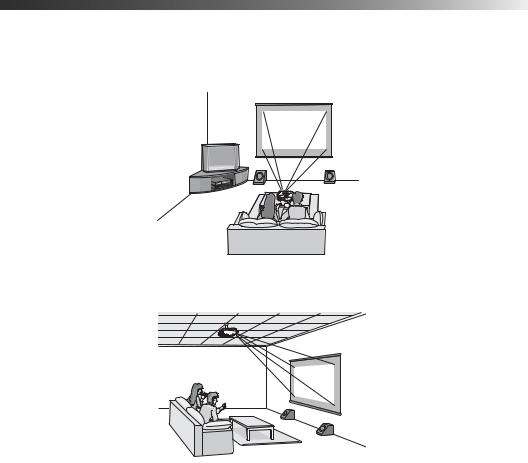
Setting Up the Projector
Follow the instructions in this section to choose a location for the projector, connect the cables, and display an image.
Choose a Location
You can install the projector for the viewing setups shown below, as well as rear projection.
Center
Ceiling
14 Setting Up the Projector

Keep the projector level and place it at a height so its lens is even with the top or the bottom of the screen and is centered horizontally. If this isn’t possible, use the horizontal keystone slider and vertical keystone buttons to adjust the image (see page 27).
Note: Image quality is reduced if keystone correction is used. For the best possible image quality, avoid using keystone correction.
Projection distance |
Offset |
Diagonal image size
Offset refers to distance from bottom of image to center of lens.
The size of the image is determined by the distance from the projector’s lens to the screen. Depending on your display settings and how you use the zoom ring, the actual size may differ. Use these tables as a guide for projector placement:
16:9 aspect ratio
|
Diagonal image size |
|
Projection distance |
(width × height) |
Offset |
|
|
|
3.8 to 6.2 feet |
40 in. (35 × 20 in.) |
0.1 in. |
116 to 190 cm |
101.6 cm (89 × 50 cm) |
(0 cm) |
|
|
|
5.8 to 9.4 feet |
60 in. (51 × 30 in.) |
0.1 in. |
176 to 287 cm |
152.4 cm (130 × 75 cm) |
(0 cm) |
|
|
|
7.7 to 12.6 feet |
80 in. (71 × 39 in.) |
0.1 in. |
235 to 383 cm |
203.2 cm (180 × 100 cm) |
(0 cm) |
|
|
|
9.7 to 15.7 feet |
100 in. (87 × 47 in.) |
0.1 in. |
295 to 480 cm |
254 cm (220 × 120 cm) |
(0 cm) |
|
|
|
11.6 to 18.9 feet |
120 in. (106 × 59 in.) |
0.1 in. |
354 to 576 cm |
304.9 cm (270 × 150 cm) |
(0 cm) |
|
|
|
14.6 to 23.7 feet |
150 in. (130 × 75 in.) |
0.2 in. |
444 to 721 cm |
361 cm (330 × 190 cm) |
(1 cm) |
|
|
|
17.5 to 28.4 feet |
180 in. (173 × 98 in.) |
0.3 in. |
533 to 866 cm |
457 cm (440 × 250 cm) |
(1 cm) |
|
|
|
Setting Up the Projector 15
4:3 aspect ratio
|
Diagonal image size |
|
Projection distance |
(width × height) |
Offset |
|
|
|
4.7 to 7.6 feet |
40 in. (32 × 24 in.) |
0.1 in. |
143 to 233 cm |
101.6 cm (81 × 61 cm) |
(0 cm) |
|
|
|
7.1 to 11.5 feet |
60 in. (47 × 35 in.) |
0.1 in. |
216 to 352 cm |
152.4 cm (120 × 90 cm) |
(0 cm) |
|
|
|
9.5 to 15.4 feet |
80 in. (63 × 47 in.) |
0.1 in. |
289 to 470 cm |
203.2 cm (160 × 120 cm) |
(0 cm) |
|
|
|
11.8 to 19.3 feet |
100 in. (79 × 59 in.) |
0.2 in. |
361 to 588 cm |
254 cm (200 × 150 cm) |
(0 cm) |
|
|
|
14.2 to 23.2 feet |
120 in. (94 × 71 in.) |
0.2 in. |
434 to 706 cm |
304.8 cm (240 × 180 cm) |
(0 cm) |
|
|
|
17.8 to 29 feet |
150 in. (118 × 91 in.) |
0.3 in. |
544 to 883 cm |
381 cm (300 × 230 cm) |
(1 cm) |
|
|
|
23.8 to 38.7 feet |
200 in. (161 × 118 in.) |
0.3 in. |
726 to 1179 cm |
508 cm (410 × 300 cm) |
(1 cm) |
|
|
|
To determine the exact image size when you know the projection distance (or the exact projection distance when you know the desired image size), you can use the Image Size Calculator. This program is available on the Epson website at epson.com/support (U.S.) or epson.ca/support (Canada).
Also keep these considerations in mind:
■Make sure there is plenty of space for ventilation around and under the projector. Do not set the projector on top of loose materials that could block the vents underneath.
■Make sure the projector is within 9.8 feet (3 m) of a grounded electrical outlet or extension cord.
16 Setting Up the Projector

In order to view 3D images correctly, 3D glasses must be worn within 32 feet (10 m) of the projector. Use the image below to determine the viewing distance for 3D projection (the shading represents the 3D viewing area):
Installing the Projector
To install the projector, you first need to determine the location, based on the size of your screen (maximum diagonal image size). Use the tables on page 15 as a guide to positioning the projector.
To suspend the projector from a ceiling, you will need the optional projector mount designed for the projector. See page 12 for ordering information. Follow the instructions included with the mount to install the projector.
Warning: When installing or adjusting the ceiling mount, do not use adhesives to prevent the screws from loosening and do not use any type of oil or lubricant. These may cause the projector casing to crack and the projector may fall, causing serious injury and serious damage to the projector.
If you install the projector on the ceiling, you will need to invert the picture so that it appears right side up. Follow these steps:
1.Press the Menu button on the remote control.
2.Open the Settings menu, then select Projection.
3.Select Front/Ceiling.
4.Press the Menu button to exit the menu system.
Setting Up the Projector 17
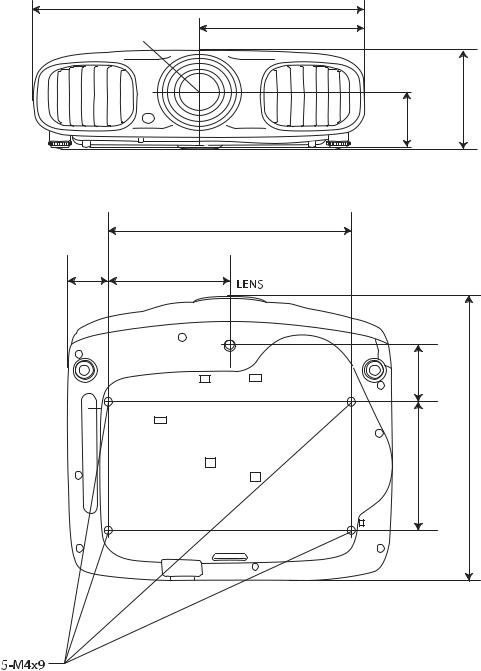
The following illustrations show the dimensions of the projector:
16.5 in. (420 mm) |
8.3 in. (210 mm) |
Center of lens |
5.5 in. |
(139.6 mm) |
3.2 in. |
(80 mm) |
|
11.8 in. (300 mm) |
2.4 in. |
|
(60 mm) |
5.9 in. (150 mm) |
|
|
|
2.8 in. |
|
(70 mm) |
|
14.4 in. |
|
(365 mm) |
|
6.3 in. |
|
(160 mm) |
18 Setting Up the Projector
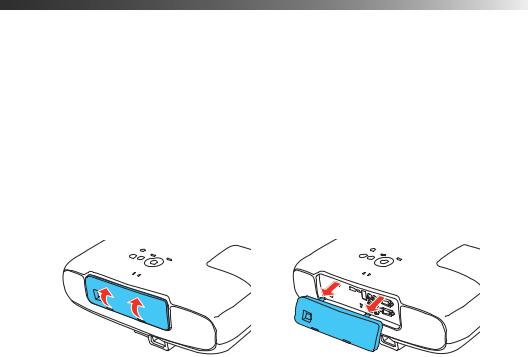
Connecting the Cables
Connecting Video and Computer Equipment
You can connect the projector to many types of video equipment, such as a Blu-ray Disc™/DVD player, digital tuner, cable or satellite box, video game console, camcorder, or digital camera. You can also connect it to a desktop or laptop PC or Apple Mac system. For details on compatible video formats, see page 89.
To remove the interface cover and connect cables to the back of the projector (PowerLite Home Cinema 3020e only), grip the cover at the gaps on the bottom of the cover and pull upwards. Swing the cover out from the projector, then pull the cover straight out to detach it.
Note: If you have trouble gripping the gaps on the bottom of the cover, use a flat object, such as a coin, to help open the cover.
To reattach the cover, insert the tabs at the top of the cover into the projector, then snap the bottom of the cover into place.
Setting Up the Projector 19
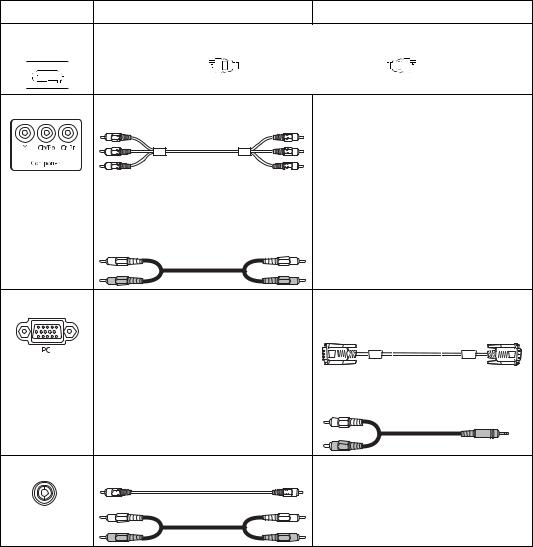
You can connect up to five pieces of equipment directly to the projector at the same time, using any of the commercially available cables shown below:
Note: See page 57 for information on connecting with WirelessHD (PowerLite Home Cinema 3020e only).
Port name |
Video equipment connection |
Computer connection |
HDMI 1/ |
Use a High Speed HDMI cable: |
|
HDMI 2 |
|
|
Component |
Use a component video cable |
— |
|
(with RCA-style connectors): |
|
|
Connect the cable to the three |
|
|
component video ports. Match |
|
|
corresponding colors between the |
|
|
cable and the ports. For audio, use a |
|
|
stereo RCA audio cable: |
|
PC |
— |
Use a Mini D-sub, 15-pin monitor cable |
|
|
to connect to a computer RGB |
|
|
(monitor) port: |
|
|
For audio, use a stereo RCA to |
|
|
mini-jack stereo (3.5 mm) audio cable: |
Video |
Use an RCA video and audio cable: |
— |
For best results, connect your video equipment to the HDMI port, if possible. If your equipment doesn’t support HDMI, connect it to either the Component (for high quality, component video) or Video (for composite video) port.
20 Setting Up the Projector

When you connect an HDMI cable to the projector, it is recommended that you fasten it with the included cable clip. Follow these steps to install the cable clip:
1.Connect the HDMI cable to one of the HDMI ports on the projector.
2.Insert the end of the cable clip anchor into the cable clip hole near the HDMI port, as show below.
3.Place the open cable clip around the HDMI cable, but don’t lock it into place.
4.Slide the cable clip towards the projector and lock the clip onto the HDMI connector.
To remove the cable clip, unlock the clip and disconnect the HDMI cable. Then pinch the side of the cable clip anchor and carefully pull it out of the cable clip hole.
Setting Up the Projector 21

Making Other Connections
Connect the power cable and other cables described below, depending on how you plan to use the projector.
■ Plug the power cable into the projector and a grounded electrical outlet.
■To use an AV controller with the projector, connect a 9-pin null modem serial cable to the RS-232C port.
■To connect to a digital camera, flash drive, or storage device, connect the USB cable that came with your device to both your device and to the projector’s USB port. For information on using the projector’s Slideshow feature, see page 35.
22 Setting Up the Projector
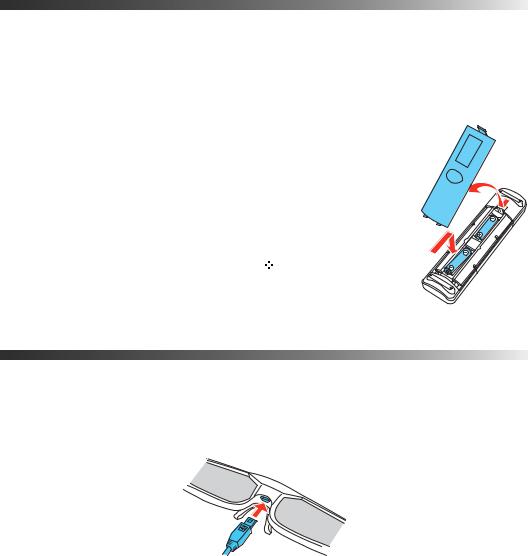
Installing Batteries in the Remote Control
The remote control uses two AA batteries.
Warning: Keep batteries away from children. If a battery is swallowed, contact your doctor immediately.
1. Release the tab and lift open the cover.
2.Insert two new AA batteries as shown.
3.Insert the tab on the cover and press it down until it clicks into
place.
Aim the remote control at the screen, or at the front or back of the projector. Make sure you are within 32 feet (10 meters) of the projector.
If you suspect the batteries are weak, press the  illumination button. If the buttons do not glow, check the battery orientation or replace the batteries.
illumination button. If the buttons do not glow, check the battery orientation or replace the batteries.
Charging the 3D Glasses
If you are using Epson RF 3D Active Shutter Glasses, follow these steps to charge the glasses:
1. Plug a USB cable into the port on the bridge of the glasses.
Setting Up the Projector 23
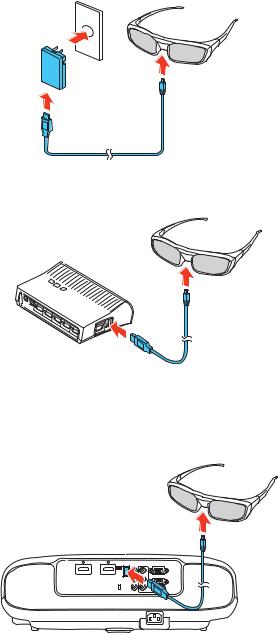
2.Do one of the following:
■Plug the other end of the USB cable into the USB to AC adapter (PowerLite Home Cinema 3020 only), then connect the adapter to a wall outlet.
■Plug the other end of the USB cable into the 3D glasses charging port on the side of the WirelessHD Transmitter (PowerLite Home Cinema 3020e only).
■Plug the other end of the USB cable into the USB-A port on the back of the projector.
Note: The projector must be turned on to charge the 3D glasses through the USB port.
24 Setting Up the Projector
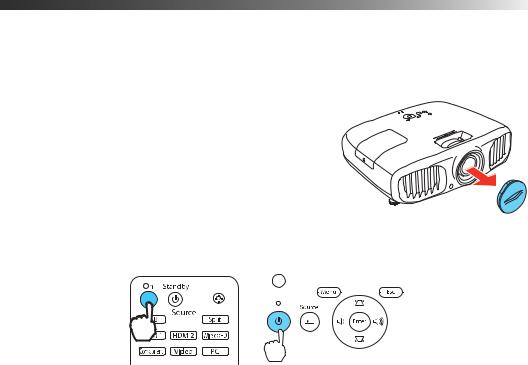
■Plug the other end of the USB cable into a computer or other device with an available USB port.
Note: Epson does not guarantee the compatibility of the Epson RF 3D active shutter glasses with computers or other devices.
Turning the Projector On and Off
Turning On the Projector
1.Remove the lens cap.
2.Turn on any connected equipment you plan to use.
3. Press the On button on the remote control or the P power button on the projector.
|
Remote control |
|
Projector |
|||||||||
|
|
|
|
|
|
|
|
|
|
|
|
|
|
|
|
|
|
|
|
|
|
|
|
|
|
|
|
|
|
|
|
|
|
|
|
|
|
|
|
|
|
|
|
|
|
|
|
|
|
|
|
|
|
|
|
|
|
|
|
|
|
|
|
|
|
|
|
|
|
|
|
|
|
|
|
|
|
|
|
|
|
|
|
|
|
|
|
|
|
|
|
|
|
|
|
|
|
|
|
|
|
|
|
Note: To prevent children from turning on the projector, you can use the Child Lock feature. See page 40 for details.
If you’ll be using the projector at an altitude above 4921 feet (1500 meters), turn on High Altitude Mode so the fan can properly cool the projector at the high altitude air pressure. See page 59 for details.
The power light flashes while the projector warms up. If you don’t see a picture, you may need to change the image source as described on page 26.
Setting Up the Projector 25

Turning Off the Projector
1.Turn off any equipment connected to the projector.
2.Press the P power button on the projector twice or press the Standby button on the remote control and wait for the light to stop flashing.
Caution: Turn off this product when not in use to prolong the life of the projector.
Selecting the Image Source
The source buttons on the projector and remote control let you switch between images from different pieces of equipment connected to the projector (such as a Blu-ray Disc/DVD player, cable or satellite box, or video game console).
Press the Source button on the remote control that corresponds to the port to which your video source is connected.
If you press the  Source button on the projector, you see a list of available sources. Press the
Source button on the projector, you see a list of available sources. Press the  Source button to move through the list and select the desired source.
Source button to move through the list and select the desired source.
26 Setting Up the Projector
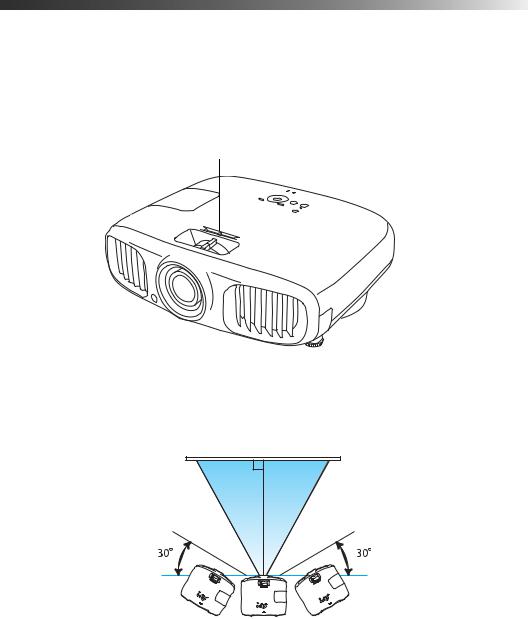
Note: If an image does not appear, see “Problem Solving” on page 77.
To temporarily turn off the image and darken the screen, press the Blank button on the remote control. Press the Blank button again to return to normal viewing.
Positioning the Image
If the projector is not centered in front of the screen, use the horizontal keystone slider, horizontal keystone buttons, and vertical keystone buttons to correct the shape of the image.
Note: For the best image quality, try to position the projector so that you do not need to use keystone correction.
Horizontal keystone slider
Note: You can display a test pattern to help adjust the image position by pressing the Pattern button on the remote control. Press the Esc button to turn off the test pattern.
The image can be adjusted up to 30° in either direction with the horizontal keystone slider or buttons:
Setting Up the Projector 27
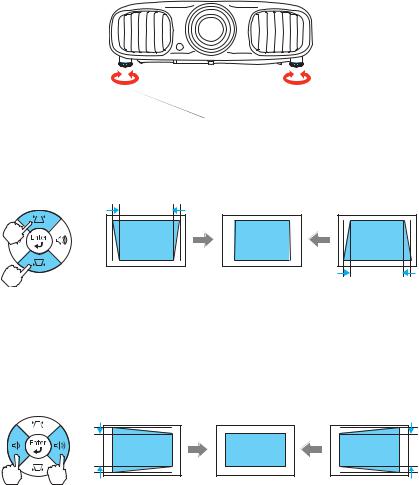
If one side of the image is taller than the other, make sure the projector is parallel to the screen. If necessary, adjust the front feet so that the projector is horizontal.
Adjustable feet
Your projector automatically adjusts images that are wider at the top or bottom, but if necessary, you can also use the vertical keystone buttons on the projector to correct this.
In addition to the horizontal keystone slider, you can use the volume buttons on the projector to adjust images that are wider on the left or right side.
Note: Press either of the vertical keystone buttons to open the H/V–Keystone menu before pressing the volume buttons. The volume buttons won’t adjust the H-Keystone setting unless this menu is active.
28 Setting Up the Projector
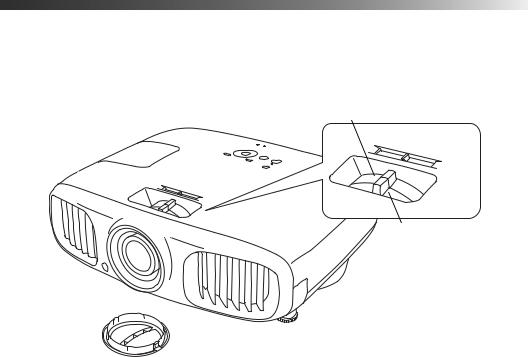
Making Basic Adjustments
Follow the instructions in this chapter to make basic adjustments to the image shape, size, color, and quality. For further refinements, see “Making Detailed Adjustments” on page 42.
Focusing and Zooming
Use the focus ring to sharpen the image.
Use the zoom ring to reduce or enlarge the image.
Zoom ring
Focus ring
Making Basic Adjustments 29
